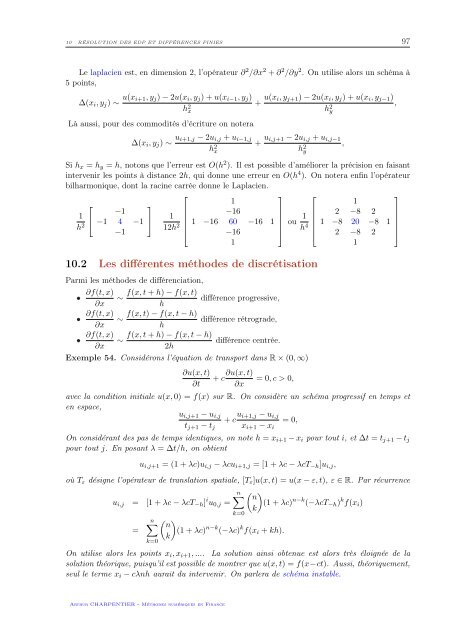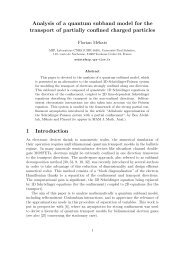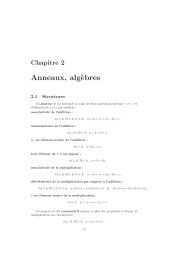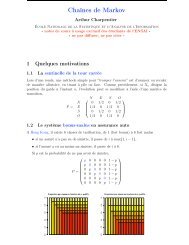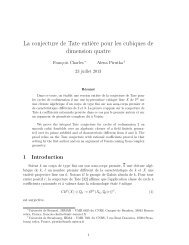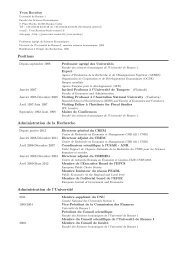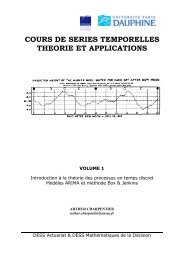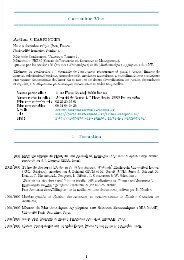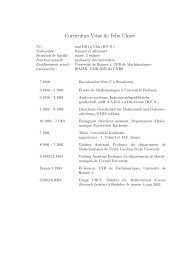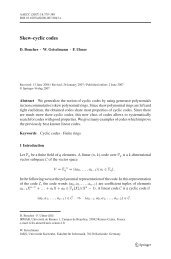Méthodes numériques en finance
Méthodes numériques en finance
Méthodes numériques en finance
Create successful ePaper yourself
Turn your PDF publications into a flip-book with our unique Google optimized e-Paper software.
10 RÉSOLUTION DES EDP ET DIFFÉRENCES FINIES 97<br />
Le laplaci<strong>en</strong> est, <strong>en</strong> dim<strong>en</strong>sion 2, l’opérateur ∂ 2 /∂x 2 + ∂ 2 /∂y 2 . On utilise alors un schéma à<br />
5 points,<br />
∆(x i , y j ) ∼ u(x i+1, y j ) − 2u(x i , y j ) + u(x i−1 , y j )<br />
h 2 x<br />
Là aussi, pour des commodités d’écriture on notera<br />
+ u(x i, y j+1 ) − 2u(x i , y j ) + u(x i , y j−1 )<br />
h 2 ,<br />
y<br />
∆(x i , y j ) ∼ u i+1,j − 2u i,j + u i−1,j<br />
h 2 x<br />
+ u i,j+1 − 2u i,j + u i,j−1<br />
h 2 ,<br />
y<br />
Si h x = h y = h, notons que l’erreur est O(h 2 ). Il est possible d’améliorer la précision <strong>en</strong> faisant<br />
interv<strong>en</strong>ir les points à distance 2h, qui donne une erreur <strong>en</strong> O(h 4 ). On notera <strong>en</strong>fin l’opérateur<br />
bilharmonique, dont la racine carrée donne le Laplaci<strong>en</strong>.<br />
⎡<br />
⎤ ⎡<br />
⎤<br />
⎡<br />
⎤<br />
1<br />
1<br />
−1<br />
1<br />
⎣<br />
h 2 −1 4 −1 ⎦<br />
1<br />
−16<br />
12h<br />
−1<br />
2 ⎢ 1 −16 60 −16 1<br />
⎥<br />
⎣ −16 ⎦ ou 1 2 −8 2<br />
h 4 ⎢ 1 −8 20 −8 1<br />
⎥<br />
⎣ 2 −8 2 ⎦<br />
1<br />
1<br />
10.2 Les différ<strong>en</strong>tes méthodes de discrétisation<br />
Parmi les méthodes de différ<strong>en</strong>ciation,<br />
∂f(t, x) f(x, t + h) − f(x, t)<br />
• ∼ différ<strong>en</strong>ce progressive,<br />
∂x<br />
h<br />
∂f(t, x) f(x, t) − f(x, t − h)<br />
• ∼ différ<strong>en</strong>ce rétrograde,<br />
∂x<br />
h<br />
∂f(t, x) f(x, t + h) − f(x, t − h)<br />
• ∼ différ<strong>en</strong>ce c<strong>en</strong>trée.<br />
∂x<br />
2h<br />
Exemple 54. Considérons l’équation de transport dans R × (0, ∞)<br />
∂u(x, t)<br />
∂t<br />
∂u(x, t)<br />
+ c = 0, c > 0,<br />
∂x<br />
avec la condition initiale u(x, 0) = f(x) sur R. On considère un schéma progressif <strong>en</strong> temps et<br />
<strong>en</strong> espace,<br />
u i,j+1 − u i,j<br />
t j+1 − t j<br />
+ c u i+1,j − u i,j<br />
x i+1 − x i<br />
= 0,<br />
On considérant des pas de temps id<strong>en</strong>tiques, on note h = x i+1 − x i pour tout i, et ∆t = t j+1 − t j<br />
pour tout j. En posant λ = ∆t/h, on obti<strong>en</strong>t<br />
u i,j+1 = (1 + λc)u i,j − λcu i+1,j = [1 + λc − λcT −h ]u i,j ,<br />
où T ε désigne l’opérateur de translation spatiale, [T ε ]u(x, t) = u(x − ε, t), ε ∈ R. Par récurr<strong>en</strong>ce<br />
n∑<br />
( n<br />
u i,j = [1 + λc − λcT −h ] i u 0,j = (1 + λc)<br />
k)<br />
n−k (−λcT −h ) k f(x i )<br />
=<br />
n∑<br />
k=0<br />
k=0<br />
( n<br />
k)<br />
(1 + λc) n−k (−λc) k f(x i + kh).<br />
On utilise alors les points x i , x i+1 , .... La solution ainsi obt<strong>en</strong>ue est alors très éloignée de la<br />
solution théorique, puisqu’il est possible de montrer que u(x, t) = f(x−ct). Aussi, théoriquem<strong>en</strong>t,<br />
seul le terme x i − cλnh aurait du interv<strong>en</strong>ir. On parlera de schéma instable.<br />
Arthur CHARPENTIER - Méthodes numériques <strong>en</strong> Finance


